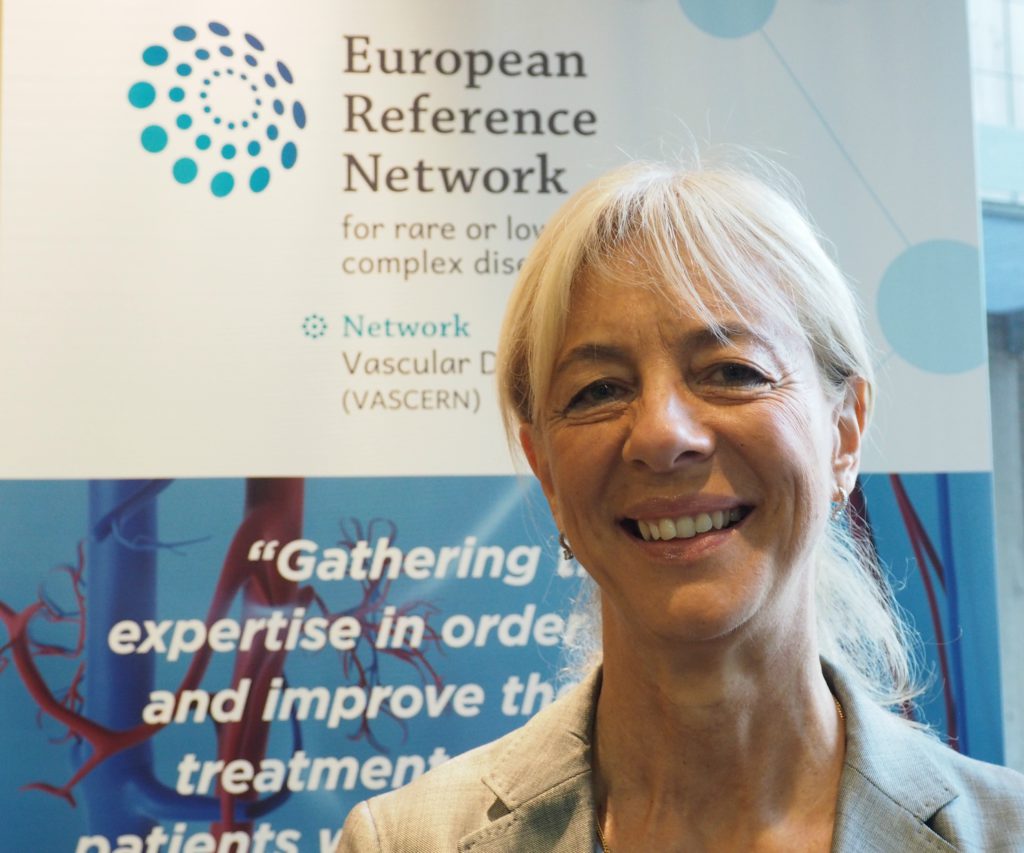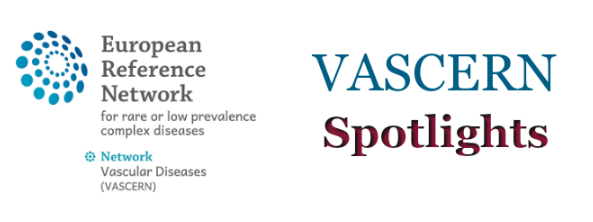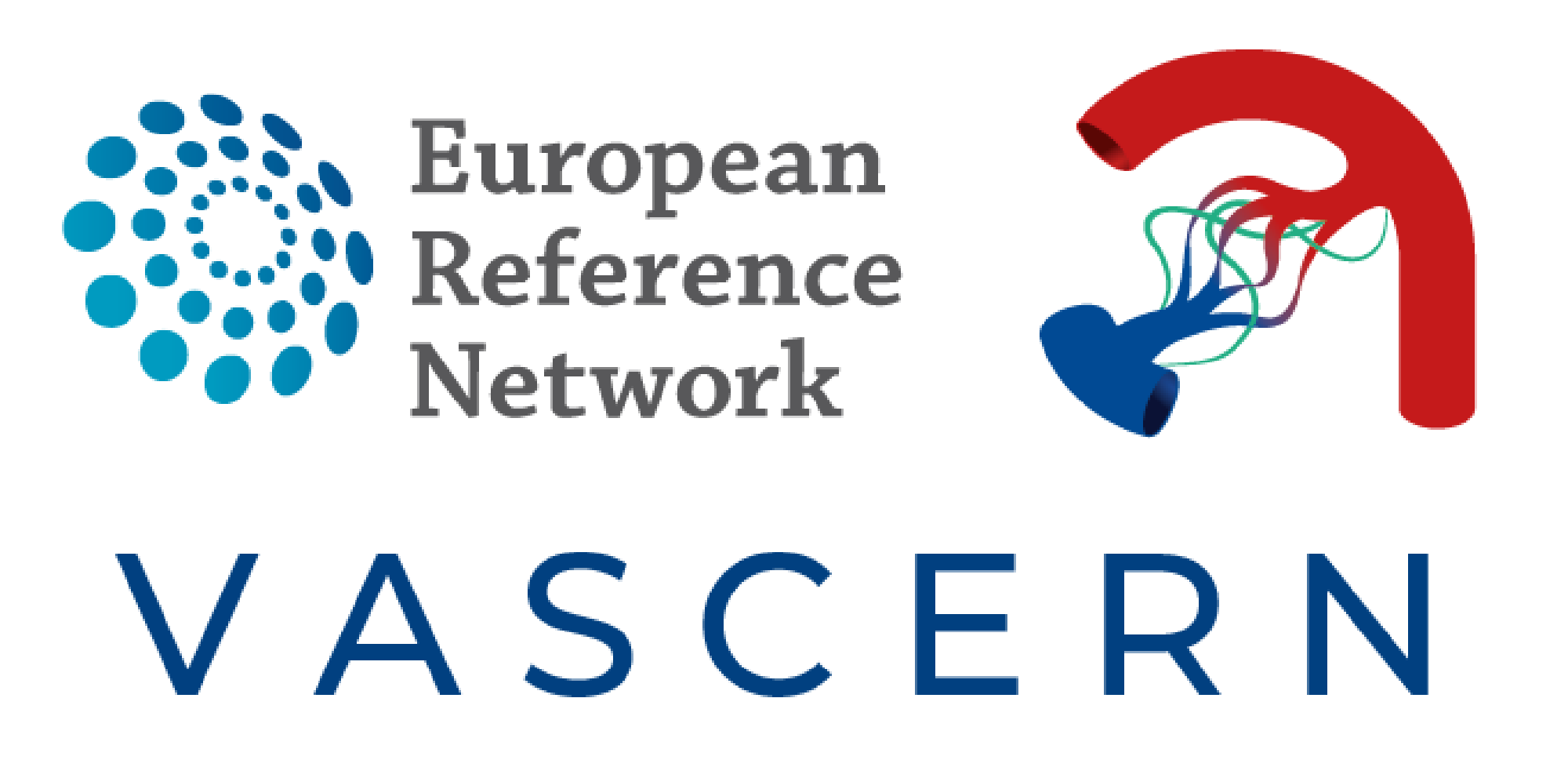

This month we have the pleasure to talk to Professor Elisabetta Buscarini, Deputy Co-Chair of the Hereditary Hemorrhagic Telangiectasia Working Group (HHT WG), from Crema, Italy. Prof Buscarini shares with us what she feels is the greatest challenge of working in the rare disease field (and the solution to overcome this challenge), what she is most proud of when it comes to her work on HHT and what she enjoys most about her participation within VASCERN.
1. What disease(s) do you specialize in (or what is your medical specialty) and what interested you in this field?
My first specialization is in internal medicine, the general study of medicine devoted to every non-surgical disorder, which I feel is a very important background to have as it gives me a very comprehensive view of the patients and trained me in many techniques (e.g. how to read electrocardiograms, X-rays etc.). I then further specialized in gastroenterology and endoscopy for digestive diseases. I am dedicated to digestive diseases that affect the liver, pancreas, and digestive tract but I have more of a global view of these diseases thanks to my double specialization. My special interest in this field is in liver diseases (e.g. benign or malignant tumours (such as hepatocellular carcinoma)) and pancreatic diseases such as malignant tumours of the pancreas. I am particularly involved in the instrumental diagnosis of pancreatic tumours using either endoscopy or sonography. Finally, in the beginning of the 90s, I became interested in HHT when I discovered a particular method of using Doppler sonography for investigating liver involvement in HHT, which is very frequent in these patients, and I have since dedicated much interest into the diagnosis of liver involvement in HHT (with all its related aspects) and the disease in general.
2. How did you become involved in VASCERN?
I heard about VASCERN as I applied to the ERN call in 2016. Maggiore Hospital, ASST Crema was one of the eight Healthcare Providers (HCPs) in Europe to be acknowledged as a recognized reference center for HHT and to join VASCERN. I have therefore been highly involved since the start as Deputy Co-Chair of the HHT WG, along with Prof Claire Shovlin (Chair) and Sophie Dupuis-Girod (Co-Chair).
In the era of linear cuts to healthcare spending, physicians with expertise in rare diseases should be considered, and protected, as an “endangered species” at risk of extinction.
3. What is your greatest hope for VASCERN?
My greatest hope is that VASCERN will help healthcare professionals treating rare diseases to work more efficiently and effectively for the patients. We are often overwhelmed by the clerical work that we face nowadays. We hope that VASCERN will not only be an additional administrative burden but that this added effort will lead to an improvement in our daily work and in the management of our rare disease patients. Otherwise this will lead to much frustration. My hope is that there will be a sufficient advocacy capacity within VASCERN to present to the European Commission the real situation of the rare disease healthcare systems all across Europe so that the networks are sustainable.
4. What challenges do you face as a healthcare professional in the rare disease field?
The most important challenge is resources: this can include funding, instrumentation, and above all, human resources, which is the most important and crucial challenge nowadays. We have had regular meetings in our region of Italy since the beginning of the ERNs to discuss problems related to rare diseases and the most significant fear we have is that when we look around the room we see each other getting older and older. Most of the people in the room are around the age of 55-60 and will soon be approaching retirement, so we absolutely need a generational shift to pass the expertise to the next generation. If we do not find sufficient motivation for these younger doctors to work in this field, and have an appropriate framework to work together with them now, then we will not have a next generation. And this is not a problem that is only limited to Italy, it is a common issue in many countries and there are two reasons for this. Firstly, there is a poor preparation at the academic level as instruction is proportionate to epidemiology, so for rare diseases there is only a small section in the medical text books. Secondly, only if you have regular recruitment and training of doctors for the replacement of retired physicians will there not be a shortage of experts. Unfortunately this is not the case and often we do not have sufficient staff to replace these retired experts. If the European Commission really has ERNs in the spotlight then they should realize that the HCPs in the ERNs should be considered differently and allocate additional human resources to them in order to ensure that this expertise is not lost. In the era of linear cuts to healthcare spending, physicians with expertise in rare diseases should be considered, and protected, as an “endangered species” at risk of extinction.
Our center has the greatest experience in the liver complications of HHT in the world and that has allowed us to give sound advice, based on sound data, which is often so difficult to find in the field of rare diseases. This data that we have been building with my group over almost 30 years is very important for the patients.
5. What have you accomplished in your medical career that you are most proud of?
In the field of rare diseases I am most proud of the work my group does on liver complications of HHT. We have performed liver examinations in all patients since 1992, so we have been accumulating a really unique set of data and experience on this complication. Our center has the greatest experience in the liver complications of HHT in the world and that has allowed us to give sound advice, based on sound data, which is often so difficult to find in the field of rare diseases. This data that we have been building with my group over almost 30 years is very important for the patients. Another thing that I am very satisfied with is how we strive for patient empowerment, as we have been collaborating with patient associations since the beginning of our experience in the ‘90s, and we have had this beautiful experience of giving and receiving when communicating between patients and healthcare professionals that is so rewarding. As healthcare professionals we have learned so much from discussions with the patient advocates. One example is how to really speak to the patients: how to speak at a level that is clear and understandable while considering their issues and fears. So it is a very important experience that is beneficial for both patients and healthcare professionals and it leads to a very good collaboration in our group where all can express their point of view freely. I hope this experience will be amplified within VASCERN, which has the potential to enhance the patient-professional collaboration.
6. Are you currently involved in any research projects or clinical trials? If so can you please describe them briefly?
At my center, for the past ten years we have been studying the treatments for gastrointestinal bleeding in HHT and in particular what therapeutic effects endoscopic treatments may have in this group of patients. In the HHT WG we also have the multicenter, randomized, open-label, SAIPAN trial that we are starting, which is led by a Dutch team, and which will evaluate the effectiveness of Octreotide (a somatostatin analog) in HHT patients who suffer from gastrointestinal bleeding.
I believe this applies to all of VASCERN, but in particular I can speak for the HHT WG, that the expert collaboration has reached a very good level.
7. What VASCERN activities do you participate in and which are your favorite?
I really enjoy the face-to-face meetings that we have had as they are great occasion to work together and I believe that we have exploited them to the maximum. I also really enjoy the monthly videoconference meetings, despite the fact that they are demanding and can conflict with our daily activities, as having this regularity with our meetings is very beneficial to us all. Another very enjoyable and important result of our collaboration is the production of various documents dedicated to all aspects of patient care and particularly to safety (e.g. multicenter surveys, consensus statements, outcome measures, Dos and Don’ts factsheets, etc.) that the VASCERN HHT WG has released to date.
8. What are the main achievements of VASCERN to date? What challenges does VASCERN still face?
I believe this applies to all of VASCERN, but in particular I can speak for the HHT WG, that the expert collaboration has reached a very good level. Certainly the experts of the HHT WG knew each other before the ERNs, but this experience has only reinforced our strong collaboration. What is really true in our group is that we are not only a multidisciplinary group be we have multiple competencies and because of this we have the best expertise in Europe at the moment on this topic.
The main challenge for VASCERN, as I mentioned above, is human resources. It is the major problem in my eyes. I think that the millennial generation (aged 30-35) has to be involved and trained in rare diseases and if they are not working with us now, they will not receive this training that is absolutely essential in order to ensure that there are rare disease experts in the future.


